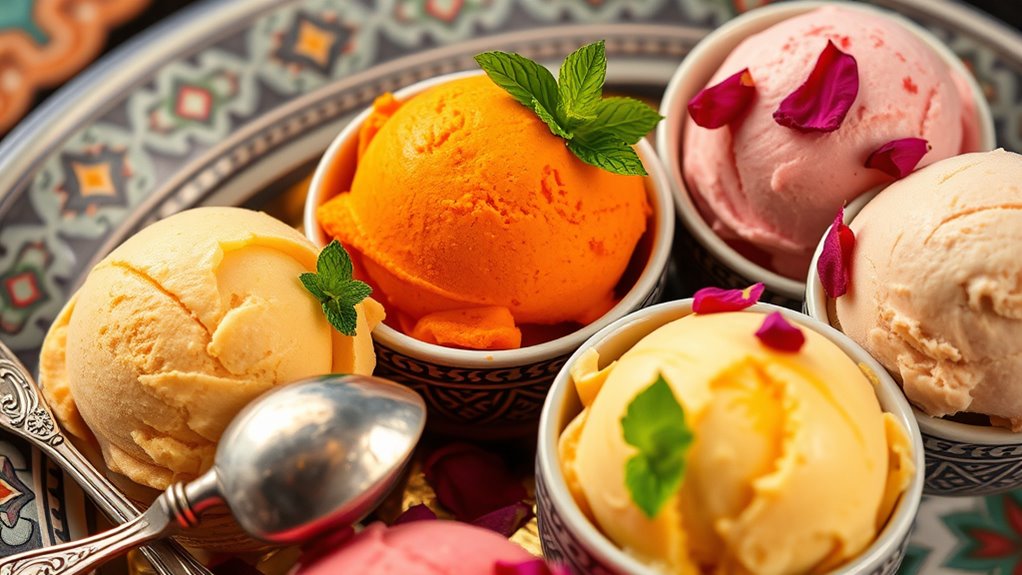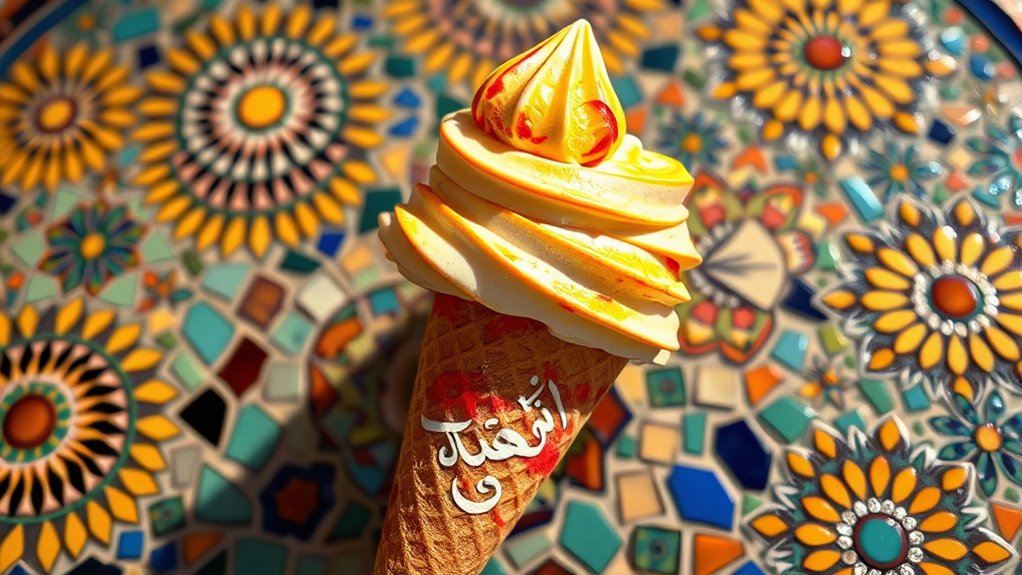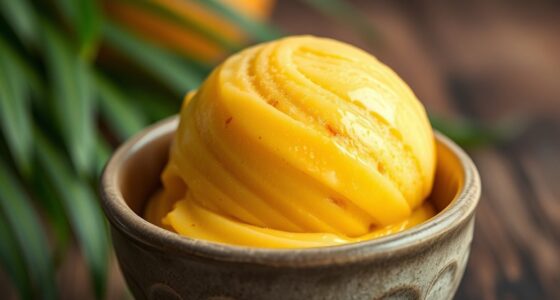Middle Eastern influences on gelato are evident through ingredients like saffron, pistachios, and floral flavors that trace back to ancient Iranian and regional desserts such as bastani and faludeh. These iconic ingredients add depth, nutty richness, and aromatic appeal, which have become signature flavors worldwide. The region’s trade routes helped spread these traditions, influencing global frozen treats. To discover how these flavors continue to inspire modern creations, keep exploring their rich culinary history.
Key Takeaways
- Middle Eastern ingredients like saffron and pistachios are commonly incorporated into modern gelato flavors.
- Traditional techniques, such as using floral extracts like salaab, influence gelato flavor combinations.
- Regional frozen desserts like bastani and faludeh have inspired gelato recipes emphasizing floral and nutty profiles.
- Middle Eastern trade routes facilitated the spread of flavors and techniques that shaped global gelato innovations.
- Cultural appreciation of Middle Eastern flavors has led to their integration into contemporary gelato menus worldwide.

Have you ever wondered how Middle Eastern traditions shaped the world’s favorite frozen desserts? The answer lies in the rich history of Persian ice cream, known as bastani, which dates back thousands of years. This traditional Iranian treat showcases the region’s innovative use of ingredients like salaab, saffron, pistachios, and heavy cream, creating a dessert that’s both flavorful and uniquely textured.
Salaab, derived from orchid extract, is essential to bastani, giving it a chewy, stretchy quality and a floral aroma that’s instantly recognizable. This ingredient, combined with the fragrant saffron, elevates the dessert beyond simple sweetness, adding depth and a luxurious richness that has influenced many regional variations across the Middle East.
As you explore these frozen desserts, you’ll notice how they differ from one area to another, reflecting local ingredients and tastes. In Iran, for example, traditional Iranian treats include not only bastani but also faludeh—a sorbet made with rice noodles and rosewater—highlighting regional variations that emphasize floral and fruity flavors.
Fruit popsicles made from local fruits like dogberries also showcase how regional ingredients shape regional variations of frozen desserts. These treats have been passed down through generations, blending local produce with ancient techniques, creating a diverse array of flavors and textures that remain beloved today.
Middle Eastern influences didn’t stay confined to the region; they traveled through Arab trade routes and conquests, eventually reaching Europe and America. These influences introduced new techniques and ingredients, helping to shape modern ice cream and sorbet recipes worldwide.
The use of floral and nutty flavors, like saffron and pistachios, became hallmarks of Middle Eastern-influenced frozen desserts, inspiring countless variations around the globe. Today’s gelato and ice cream often incorporate these ingredients, reflecting a legacy rooted in centuries-old Persian innovations.
Additionally, the spread of Middle Eastern flavors through trade and cultural exchange played a crucial role in shaping global frozen dessert traditions.
In essence, the history of Middle Eastern frozen desserts demonstrates how a region’s culinary ingenuity can influence global tastes. From the elastic, floral bastani of Persia to regional variations like faludeh and fruit popsicles, these traditional Iranian treats reveal a deep connection between ancient ingredients, regional flavors, and cultural exchanges.
Thanks to Arab trade, these influences spread far beyond their origins, enriching the world’s dessert landscape. Whether you’re enjoying a saffron-infused gelato or a rosewater sorbet, you’re experiencing a part of a long, fascinating history of Middle Eastern innovation in frozen desserts.
Frequently Asked Questions
Is Gelato Arabic?
You’re asking if gelato is Arabic, but it’s actually Italian. However, Middle Eastern and Arab frozen dessert traditions heavily influenced its development. They introduced techniques like using snow and floral flavorings, which European cultures adapted.
Did Persians Invent Ice Cream?
Think of Persian innovation as planting a seed that blooms into ice cream. Yes, Persians are credited with inventing some of the earliest frozen desserts around 550 BC, crafting unique treats like bastani with saffron and pistachios.
They developed techniques like salaab, giving their ice cream a chewy, elastic texture. Their rich tradition influenced later cultures, making Persian frozen desserts a cornerstone in the history of ice cream.
Where Did Gelato Originate From?
You might wonder where gelato originated from. It all began in ancient Rome, where people enjoyed flavored ice desserts made from snow, honey, and fruit juices.
Over time, Arab traders introduced sherbet, which influenced gelato’s development.
The Middle Ages saw further innovations in ice preservation and ingredients like sugar and milk. These combined influences led to the rich tradition of gelato you enjoy today, primarily rooted in Italy.
Can Muslims Have Gelato?
You can enjoy gelato if it’s made with halal ingredients and doesn’t contain anything forbidden, like alcohol or non-halal gelatin. Look for products with halal certification and read labels carefully.
Many shops offer alcohol-free flavors, and Muslim-owned gelato shops often follow strict guidelines.
As long as you choose the right options, gelato can be a delicious and permissible treat for you.
Conclusion
You might be surprised to learn that Middle Eastern flavors now make up over 30% of artisanal gelato recipes worldwide. This fusion invites you to explore unique tastes like pistachio, saffron, and rosewater in every scoop. Embracing these influences not only broadens your palate but also celebrates a rich cultural exchange. So, next time you indulge, remember you’re tasting centuries of history and tradition blended into a single, delightful bite.
















